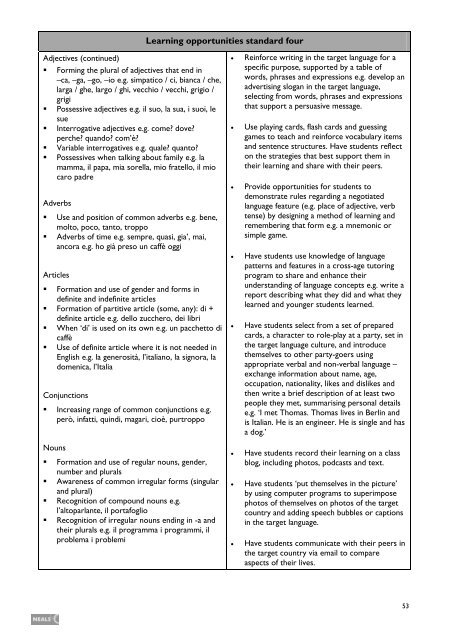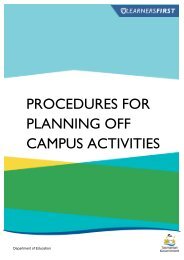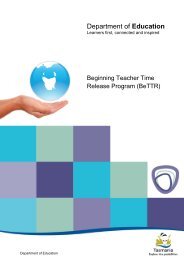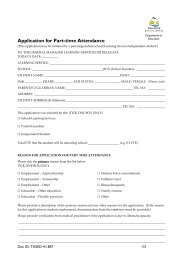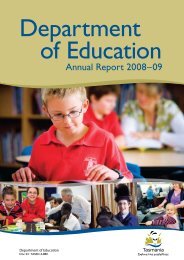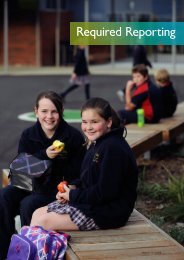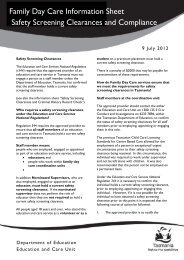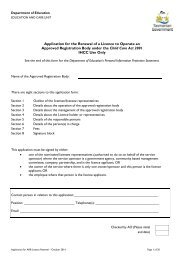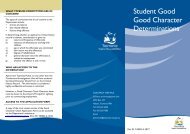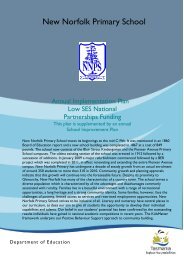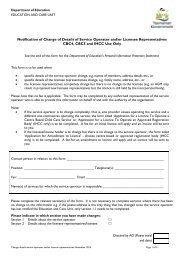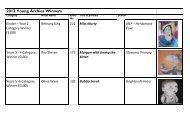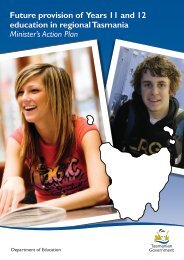Tas Curriculum K-10 - Languages - Italian - Department of Education
Tas Curriculum K-10 - Languages - Italian - Department of Education
Tas Curriculum K-10 - Languages - Italian - Department of Education
You also want an ePaper? Increase the reach of your titles
YUMPU automatically turns print PDFs into web optimized ePapers that Google loves.
Adjectives (continued)<br />
Forming the plural <strong>of</strong> adjectives that end in<br />
–ca, –ga, –go, –io e.g. simpatico / ci, bianca / che,<br />
larga / ghe, largo / ghi, vecchio / vecchi, grigio /<br />
grigi<br />
Possessive adjectives e.g. il suo, la sua, i suoi, le<br />
sue<br />
Interrogative adjectives e.g. come? dove?<br />
perche? quando? com’è?<br />
Variable interrogatives e.g. quale? quanto?<br />
Possessives when talking about family e.g. la<br />
mamma, il papa, mia sorella, mio fratello, il mio<br />
caro padre<br />
Adverbs<br />
Use and position <strong>of</strong> common adverbs e.g. bene,<br />
molto, poco, tanto, troppo<br />
Adverbs <strong>of</strong> time e.g. sempre, quasi, gia’, mai,<br />
ancora e.g. ho già preso un caffè oggi<br />
Learning opportunities standard four<br />
Articles<br />
Formation and use <strong>of</strong> gender and forms in<br />
definite and indefinite articles<br />
Formation <strong>of</strong> partitive article (some, any): di +<br />
definite article e.g. dello zucchero, dei libri<br />
When ‘di’ is used on its own e.g. un pacchetto di<br />
caffè<br />
Use <strong>of</strong> definite article where it is not needed in<br />
English e.g. la generosità, l’italiano, la signora, la<br />
domenica, l’Italia<br />
Conjunctions<br />
Increasing range <strong>of</strong> common conjunctions e.g.<br />
però, infatti, quindi, magari, cioè, purtroppo<br />
Nouns<br />
Formation and use <strong>of</strong> regular nouns, gender,<br />
number and plurals<br />
Awareness <strong>of</strong> common irregular forms (singular<br />
and plural)<br />
Recognition <strong>of</strong> compound nouns e.g.<br />
l’altoparlante, il portafoglio<br />
Recognition <strong>of</strong> irregular nouns ending in -a and<br />
their plurals e.g. il programma i programmi, il<br />
problema i problemi<br />
• Reinforce writing in the target language for a<br />
specific purpose, supported by a table <strong>of</strong><br />
words, phrases and expressions e.g. develop an<br />
advertising slogan in the target language,<br />
selecting from words, phrases and expressions<br />
that support a persuasive message.<br />
• Use playing cards, flash cards and guessing<br />
games to teach and reinforce vocabulary items<br />
and sentence structures. Have students reflect<br />
on the strategies that best support them in<br />
their learning and share with their peers.<br />
• Provide opportunities for students to<br />
demonstrate rules regarding a negotiated<br />
language feature (e.g. place <strong>of</strong> adjective, verb<br />
tense) by designing a method <strong>of</strong> learning and<br />
remembering that form e.g. a mnemonic or<br />
simple game.<br />
• Have students use knowledge <strong>of</strong> language<br />
patterns and features in a cross-age tutoring<br />
program to share and enhance their<br />
understanding <strong>of</strong> language concepts e.g. write a<br />
report describing what they did and what they<br />
learned and younger students learned.<br />
• Have students select from a set <strong>of</strong> prepared<br />
cards, a character to role-play at a party, set in<br />
the target language culture, and introduce<br />
themselves to other party-goers using<br />
appropriate verbal and non-verbal language –<br />
exchange information about name, age,<br />
occupation, nationality, likes and dislikes and<br />
then write a brief description <strong>of</strong> at least two<br />
people they met, summarising personal details<br />
e.g. ‘I met Thomas. Thomas lives in Berlin and<br />
is <strong>Italian</strong>. He is an engineer. He is single and has<br />
a dog.’<br />
• Have students record their learning on a class<br />
blog, including photos, podcasts and text.<br />
• Have students ‘put themselves in the picture’<br />
by using computer programs to superimpose<br />
photos <strong>of</strong> themselves on photos <strong>of</strong> the target<br />
country and adding speech bubbles or captions<br />
in the target language.<br />
• Have students communicate with their peers in<br />
the target country via email to compare<br />
aspects <strong>of</strong> their lives.<br />
53


